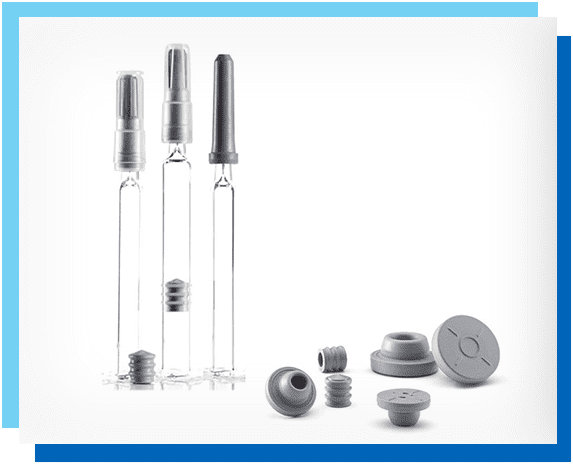Extractables & Leachables
Focused Analytical Services
Current & Future Capabilities
Current Analysis Capabilities
- Known and unknown characterization of semi- and volatile substances (GC/MS with ALS and headspace sampling capabilities), using the NIST17 library for matching of EI-generated mass spectra
- Characterization of known non-volatile substances (using a single quadrupole mass spectrometer with ESI and APCI sources, coupled to a UPLC with PDA capabilities), providing us with and the generation of unit mass resolution data for unknowns, in addition to UV spectra
- Positive analyte confirmation with the use of analytical standards (m/z and retention time)
- Ion chromatography
Upcoming Capabilities
(with a high-resolution ion mobility Q-ToF mass spectrometer coupled to a UPLC with PDA capabilities)
- The ability to characterize knowns and unknowns, including impurities in APIs and drug products
- Generation of accurate mass information
- MS/MS fragmentation pattern generation
- Molecular formula generation via accurate mass and isotope spacing information
- Collisional cross section characterization of molecules using ion mobility
- Positive analyte confirmation with the use of analytical standards, combined with retention time, accurate mass, fragmentation pattern, and collisional cross section information
- Intact mass analysis of peptides and proteins, including sequencing by MS/MS
- Examination of various post-translational modifications (i.e. glycosylation, the formation of disulfide bonds, deamidations, etc.)
Upcoming Capabilities
(with a triple quadrupole mass spectrometer coupled to a UPLC with PDA capabilities)
- Dramatically enhanced analytical sensitivities (>1500x increase in the s/n over a single quadrupole mass spectrometer)
- Ability to perform targeted trace analyte analysis (simultaneous data collection in positive, negative, and UV modes) even in the most complicated of sample matrices
- Screening and quantitation of nitrosamines and other trace impurities
Product Life Cycle Support
Component Selection Package
- Review Extractables Data Package
- Component Qualification Strategy
- Technical Assessment Report
Pharmaceutical Development
- Customized Extraction Study
- Migration Study
- Formulation Stability
- Risk Assessment Report
Regulatory Support
- Leachable study performed on stability
- Compendial Testing
- Component Change Control Studies
- Regulatory Support
Instrumentation
- LC-MS
- GC-MS
- GC-HS
- HPLC-UV
- HPLC-PDA
- UPLC
- Ion Chromatography
- ICP-MS
- FTIR
Component Reference
- Coated Stoppers
- 13 & 20 mm stoppers
- Serum stoppers
- Lyophilized stoppers
- Ready to use
- Ready to sterilize
- UDS stoppers
- Plungers

Extractables & Leachables FAQs
Q:
What is the Difference Between an Extractable and a Leachable?
A:
We use the term “Extractable” to refer to any compound can be extracted from the packaging/manufacturing materials of interest under both the nominal conditions of use, as well as under additionally aggressive extraction conditions, which can help facilitate compound identification, and provide a worst-case extractable scenario.
A “Leachable”, on the other hand, refers to a compound that is observed to leach into the drug product from the packaging and/or container closure system under expected storage conditions.
Q:
What Does the Term “Leachables” Mean?
A:
Q:
What Does an Extractable Study Look Like?
A:
In an extractable study, we can perform extractions on materials involved in the packaging and manufacture of the drug product that have the potential to impart leachables into the system (including primary and secondary container closure systems).
Each material can be treated with a variety of extraction solvents that allow us to investigate the anticipated contact-us/ing media for that material, as well as an additionally aggressive solvent to provide a “worst-case” evaluation.
All of the extractable compounds observed in excess of the predetermined limit (Analytical Evaluation Threshold, or AET) are then reported, along with any available structural information to support identification and risk analysis.
Q:
What Does a Leachable Study Look Like?
A:
In a leachable study, a set of drug product samples are aged at nominal and/or accelerated stability conditions in the final container closure system and are evaluated for leachables at multiple timepoints. The purpose of this study is to screen the samples for any leachables over time at the accelerated and actual conditions of use.
Any leachables observed during this study in excess of the pre-determined limit (Analytical Evaluation Threshold, or AET) are then reported, along with any available structural information to support identification and risk analysis.
Q:
When Should Extractable and Leachable Studies be Performed?
A:
We recommend performing extractable studies once the manufacturing and assembly process for your drug product is determined to ensure the data is as relevant and useful as possible to support your regulatory submissions.
Leachable studies should be initiated as soon as possible following selection of your final container closure system. This is recommended to avoid any potential delays as these studies require aging of the drug product on stability, which can take up to two years at nominal conditions.
Q:
What are Common Extractables and Leachables in Pharma?
A:
The most commonly observed extractable and leachable compounds in pharma are those associated with extended exposure to the drug product, and would include a variety of antioxidants, plasticizers, slip agents, lubricants, etc. Examples of components that can significantly contribute to the extractable and leachable profile of your drug product are any vial stoppers, spray pumps, and other plastic primary packaging components. Inks components have been known to migrate through the secondary packaging and into the drug product but is far less common. Evaluation of both the primary and secondary packaging componentry is key to ensuring drug product safety.
